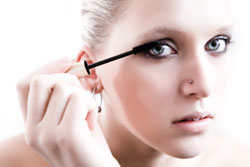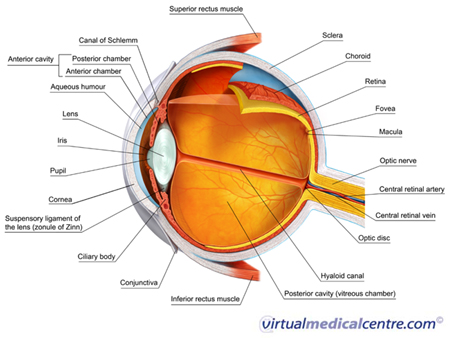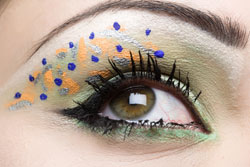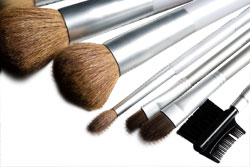- Introduction to cosmetics and the eyes
- Eye disorders associated with cosmetic use
- How to avoid eye disorders when you use cosmetics
Introduction to cosmetics and the eyes

However, eye disorders caused by cosmetic use can be avoided if the right cosmetics are purchased, stored and applied in a hygienic manner. There are many measures which cosmetic users can take to reduce their risk of developing a cosmetics-related eye disorder.

Eye disorders associated with cosmetic use
The eye disorders associated with cosmetic use are most commonly minor irritations and infections. However, more serious infections and irritations have also occurred following use of eye cosmetics and minor irritations and infections may become more serious if left untreated.
Swelling or inflammation of the eye area
The use of eyelash dyes is associated with swelling and inflammation of the eye area. In two very serious cases in the United States in the 1930s, one woman was permanently blinded and another died from the use of eye lash dyes.
The eyes may also become swollen or irritated when some other eye cosmetics are applied, or if they become infected by cosmetics, applicators or fingers during the application process.
Severe conjunctivitis, a condition in which the conjunctiva (covering of the eyeball) becomes inflamed, is associated with the application of some cosmetic products, in particular eyelash dyes.
There have also been reports of severe cases of dermatitis affecting the eyelid and causing pain and discomfort in the eye area, following the application of eyelash dyes.
How to prevent eye disorders when you use cosmetics

Eye cosmetics or their applicators are exposed to the user’s bacteria when they are used. An individual who shares their cosmetics may therefore become exposed to the bacteria of others who have used the same product. Cosmetic users should not share their cosmetics with friends or use single-use applicators if they do. Individuals who use cosmetics should also be aware that “tester” cosmetics which allow sampling of cosmetic products in stores are particularly dangerous because they are often shared by a large number of people. Individuals who decide to use testers should use a single-use applicator.
Take care when applying eye cosmetics
It is easy to poke an applicator or finger in the eye when applying cosmetics and this can scratch the eyeball or introduce bacteria into the eye. It is therefore important to take care when applying cosmetics. In particular eye cosmetics should not be applied in a moving vehicle or other situation where a sudden bump may cause an applicator to poke the eye.
Avoid cosmetics containing irritants
Many cosmetics contain chemicals and in some cases these will irritate the eyes. This is particularly likely if the cosmetic product is not specifically designed for use on the eyes but is applied to the eye area anyway (e.g. lip liner applied as eyeliner). Use of cosmetics that are not specifically developed for eye application should therefore be avoided. However, irritation can also occur with products designed specifically for use with eyes.
There have been numerous reports of cases of severe eye irritations such as conjunctivitis and dermatitis of the eyelid following the application of eyelash tints and dyes. Individuals who wish to avoid these eye disorders should avoid the use of permanent eyelash tints and dyes.
There is evidence that solvent based mascaras (e.g. those which are use petroleum distillate to maintain product consistency) cause contact dermatitis, whereas stearate based mascaras do not.
Kohl, an ingredient commonly found in eyeliners, is known to have high concentrations of lead, and while this does not directly affect the eye, it can affect an individual’s health more broadly.
In Australia, all cosmetic products require labelling with a full list of ingredients and individuals should check product labels and avoid cosmetics containing solvents, kohl and other substances to which they are hypersensitive.
Keep cosmetics (and the hands and tools that apply them) clean

- Keep cosmetics and their applicators clean and ensure they do not become covered with dirt or dust;
- Discard cosmetics which are exposed to dirt or applied during an eye infection;
- Wash their hands prior to applying cosmetics and ensure that any instruments which they use to assist in the application process are clean;
- Store cosmetics at room temperature as high temperatures may destroy the preservatives which protect them against bacteria; and
- Use cosmetics as they are. Cosmetics should not be tampered with (e.g. water should not be added if the product becomes dry) as this may introduce bacteria.
Avoid using cosmetics when the eyes are infected or irritated
Cosmetics should not be used while the eyes are infected or irritated as cosmetic use may make the infection worse. If the eyes become irritated while cosmetics are applied, they should be removed immediately and any unused portion of the product should be disposed of.
Face washing to remove cosmetics
It is important that cosmetic users thoroughly remove cosmetics and dirt from their faces everyday. This can be done using facial cleansing solutions (including soaps), facial cleansing instruments (e.g. exfoliating brushes) or a combination of the two. The best way to cleanse the face will depend on the individual’s skin type. The best cosmetic removal technique will depend on the type of cosmetic used and its properties such as if it was waterproof or water soluble.
Many soaps which are highly fragranced and suitable for cleaning the body, are unsuitable for the sensitive skin of the face. However, there are a range of soap free facial cleansing bars (e.g. beauty bar soaps) and solutions which have been developed for use on the face. They typically have a higher pH (that is, they are not as acidic as regular soap), and are thus less likely to cause irritation to the skin of the eyes and face. They may not be suitable for individuals with very oily skin, who may need to use a facial scrub or facial cloth to achieve oil removal.
Waterproof cosmetics must be removed using special facial cleansing solutions. As many of these cleansing solutions contain chemicals which may irritate the eye (e.g. cause contact dermatitis), it is safer to use cosmetic products which are not waterproof, and can therefore be removed with water alone. Contact lens users should ensure they remove their lenses prior to cleaning cosmetics from the eye area.
References
- United States Food and Drug Authority. Eye cosmetics and eyebrow/eyelash dyes. 2001. [cited 2009 May 15] available at: http://www.cfsan.fda.gov/ ~dms/ cos-821.html
- Kaiserman, I. Severe allergic blepharoconjuntivitis induced by a dye for eyelashes and eyebrows. Ocular Immunol & Infamm. 2003;11(2):149-51.
- Texeira, M. Wachter, L. Ronsyn, E. Goossens, A. Contact allergy to para-phenylenediamin in a permanent eyelash dye. Contact Dermatitis, 2006;55(2):92-4
- Gallardo, M. Randleman, J. Price, K. et al Ocular Argyosis after long term self-application of eyelash tint. Am J Ophthalmol. 2006;141(1):198-200.
- Wessman, L.J. Mascaras may cause irritant contact dermatitis. Int J Cosmetic Sci. 2002;24(5):281-5.
- Al Hazzaa, S.A. Krahn, P.M. Kohl: a hazardous eyeliner. Int Ophthalmol. 1995;19(2):83-8.
- National Industrial Chemicals Notification and Assessment Scheme, Cosmetic Guidelines 2007 [online]. Australian Government Department of Health and Ageing. 2 December 2008. [cited 15 May 2009]. Available from URL: http://www.nicnas.gov.au/
- Draelos, Z.D. Special considerations in eye cosmetics. Clin Dermatol. 2001;19:424-30.
- American Academy of Dermatology. Cutting through the clutter: making the most of your facial cleansing routine, 2005, [cited 2009, May 23], available from: http://www.prnewswire.com/ gh/ cnoc/ comp/ 638376.html
All content and media on the HealthEngine Blog is created and published online for informational purposes only. It is not intended to be a substitute for professional medical advice and should not be relied on as health or personal advice. Always seek the guidance of your doctor or other qualified health professional with any questions you may have regarding your health or a medical condition. Never disregard the advice of a medical professional, or delay in seeking it because of something you have read on this Website. If you think you may have a medical emergency, call your doctor, go to the nearest hospital emergency department, or call the emergency services immediately.







